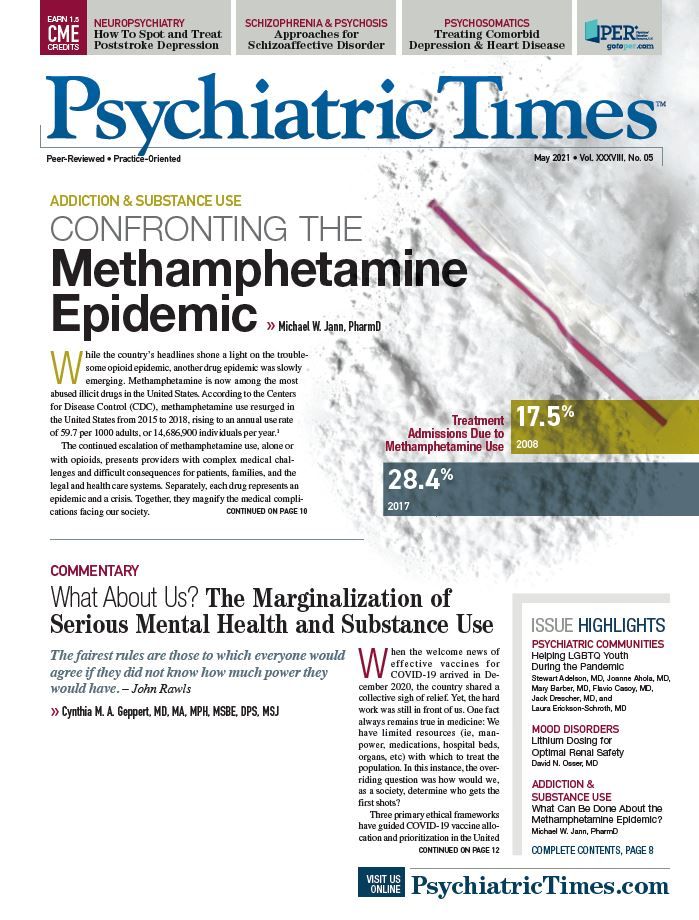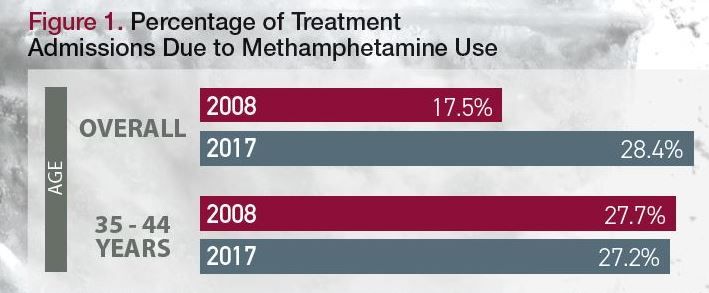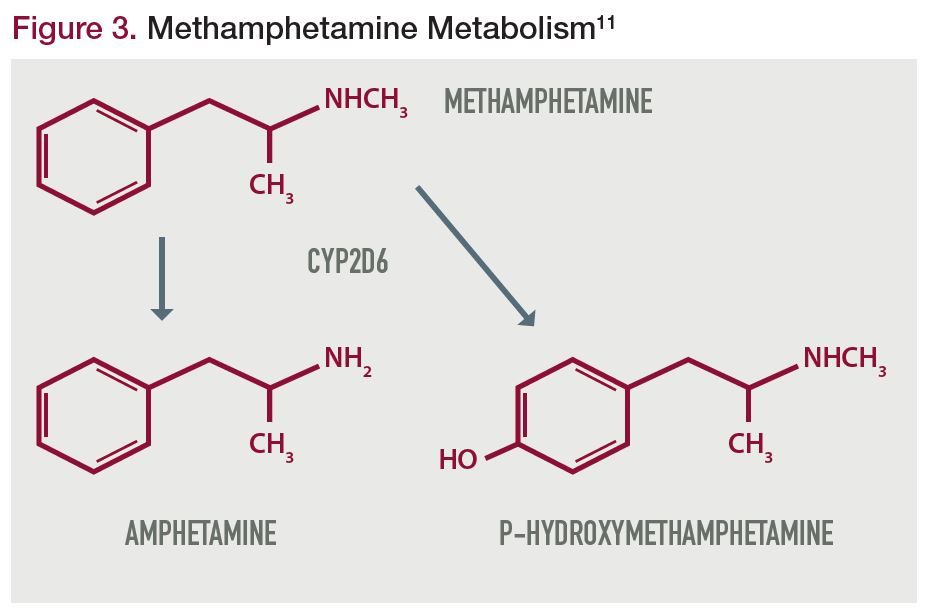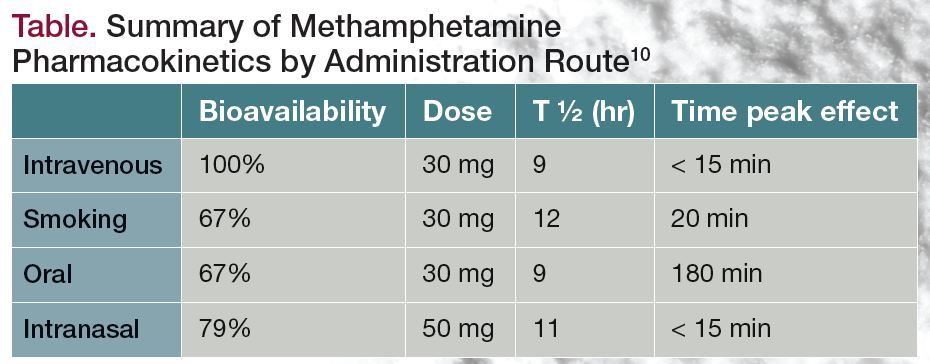Publication
Article
Psychiatric Times
Confronting the Methamphetamine Epidemic
Author(s):
As all eyes were on the pandemic, another surge simmered below the surface.
NewAfrica/AdobeStock
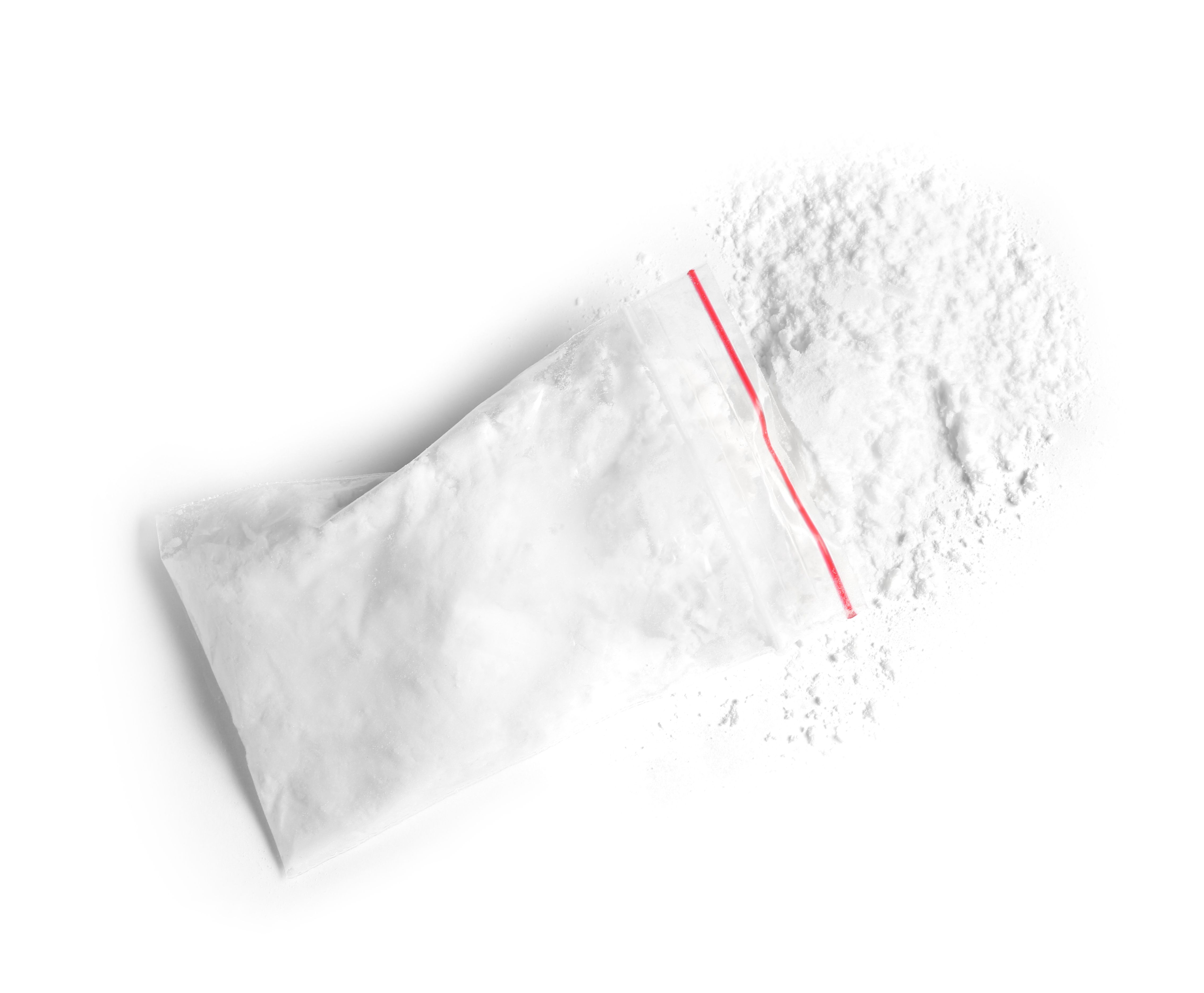
CLINICAL
While the country’s headlines shone a light on the troublesome opioid epidemic, another drug epidemic was slowly emerging. Methamphetamine is now among the most abused illicit drugs in the United States. According to the Centers for Disease Control (CDC), methamphetamine use resurged in the United States from 2015 to 2018, rising to an annual use rate of 59.7 per 1000 adults, or 14,686,900 individuals per year.1
The continued escalation of methamphetamine use, alone or with opioids, presents providers with complex medical challenges and difficult consequences for patients, families, and the legal and health care systems. Separately, each drug represents an epidemic and a crisis. Together, they magnify the medical complications facing our society.
History and Epidemiology
Unlike opioids, methamphetamine lacks US Food and Drug Administration (FDA)-approved pharmacological treatment interventions. Nevertheless, amphetamine-type stimulants (ATS), including methamphetamine, have a unique history that began during World War II; they were then used in the 1950s and 1960s for depression and obesity.2 ATS use declined in the 1970s after its reclassification to a more restrictive schedule by the Comprehensive Drug Abuse Prevention and Control Act.
Legal restrictions led to new drug forms, and the number of individuals who used methamphetamine grew. Postamphetamine rescheduling led to manufacturing methamphetamine using phenyl-2-propane (P2P) and methylamine. When P2P became a schedule II controlled substance, ephedrine and pseudoephedrine became the predominant agents used for methamphetamine synthesis. The Combat Methamphetamine Epidemic Act of 2005 limited pseudoephedrine access and banned ephedrine, but these regulations resulted in only a temporary decline in use. In 2005, there were 192,000 new methamphetamine users per year, whereas by 2012, the number had markedly increased to 440,000 individuals per year.2
According to the CDC’s report, methamphetamine use was higher in men compared with women (8.7 vs 4.7 per 1000 adults, respectively).1 Adults aged 26 to 34 years had the highest rates of methamphetamine use (11.0 per 1000 adults), followed by those aged 18 to 25 years and 35 to 49 years (9.9 and 8.3 per 1000 adults, respectively). The prevalence of methamphetamine use was greater for those making either less than $20,000 per year or between $20,000 and $49,999 per year (15.6 and 7.6 per 1000 adults, respectively), compared with those at other income levels. For almost 45% of those who used the drug, duration of use was greater than 100 days per year; nearly 25% of all individuals who used methamphetamine reported administering the drug intravenously. About 53% met the DSM-5 criteria for methamphetamine use disorder and only 31.5% received substance abuse treatment.
The CDC also compared 2008 hospital admissions with 2017 admissions, finding 15,747,334 drug-related treatment admissions in individuals 12 years or older in 2017.3 The number of treatment admissions due to methamphetamine increased substantially (Figure 1).
These increases in use and treatment translate into a huge economic burden. Using 2005 data, the RAND Corporation estimated total economic costs of $23.4 billion, including indirect costs of about $12.6 billion.2 Based upon increasing usage in the past decade, undoubtedly the economic burden of the drug has substantially increased.
The Twin Epidemics
The opioid epidemic in the United States has been well documented for a decade. The CDC reported that 70,630 fatalities was associated with drug overdoses in 2019, including all drugs.4 That year, the second-highest number of fatalities were associated with stimulant drugs, largely methamphetamine (Figure 2).
Based upon the methamphetamine use and fatality data, it is apparent that it has become a second epidemic and crisis.5,6 To complicate matters, an increasing number of individuals abuse both opioids and methamphetamine.5 The CDC reported that between 2015 and 2018, 57% of those who used methamphetamine also abused either heroin or prescription opioids.1 Similarly, hospital admissions among individuals who primarily used heroin (but also reported methamphetamine use) increased by 490% from 2008 to 2017. The most common administration routes were by (intravenous) IV injection (47.1%) and smoking (46.0%).7
A survey in rural Oregon reported that 96% of participants (N = 112) who used opioids in the past 30 days also noted methamphetamine use, and 50% injected both opioids and methamphetamine.8 Participants indicated that methamphetamine was more widely available, less expensive, and less stigmatized compared with opioids. Individuals discharged from substance abuse programs perceived methamphetamine as a drug that prevented opioid overdose. Individuals who used both opioids and methamphetamine reported that the latter could serve as an opioid substitute, provide a synergistic high, and balance out the sedation from the opioids.6 On the other hand, individuals who used methamphetamine stated that opioids can be used to mitigate the former’s negative adverse effects. They believed that the addition of small amounts of methamphetamine could prolong opioid intoxication effects, and coinjection of both had a more desirable intoxication effect than using either substance alone.9
Pharmacology
Methamphetamine exists in 2 stereoisomer forms, the D- and L-forms; the D-form is 3 to 5 times more potent than the L-form (Figure 3).2,10 Methamphetamine affects the dopamine, serotonin, and noradrenaline transporters, as well as the vesicular monoamine transporter-2.2,11 Heroin and other opioids are opioid receptor agonists.12 The opioid receptors are widely distributed in the central nervous system, including the nucleus accumbens (NAcc) and ventral tegmental area (VTA).2 Both methamphetamine and opioids promote the release of dopamine in the NAcc and VTA, indicating a common pharmacological pathway for both drugs regarding reward and reinforcement properties.13 When these agents are taken together, a pharmacodynamic synergy can occur in which dopamine release may be greater than with either agent taken alone. Further, stimulant actions may attenuate an opioid’s sedative actions, whereas opioids can prevent overstimulation by methamphetamine.
Pharmacokinetics. The route of methamphetamine administration affects its pharmacokinetics (Table).10 For instance, the IV route produces the most rapid onset of effects, whereas smoking promotes a slightly slower onset (about 20 minutes). The elimination half-life of methamphetamine is between 9 and 12 hours. Its metabolism, shown in Figure 3, is converted to 2 main metabolites: amphetamine (AMP) and the 4-hydroxy (OH) methamphetamine by the cytochrome P450 (CYP) 2D6 enzyme.10 The CYP2D6 system is prone to many possible drug-drug interactions and genetic polymorphisms (eg, extensive and poor metabolizers). Although CYP2D6 genotyping has not been conducted in methamphetamine pharmacokinetic studies, in one study, a single participant was reported to have an extremely low formation of AMP and 4-OH methamphetamine compared with the other 11 participants; it was suggested that this individual could be a poor metabolizer of CYP2D6.10
Adverse effects. A wide range of adverse effects (eg, psychological issues, withdrawal, overdose, cardiac and other medical problems) is associated with methamphetamine use.2,11 The most common psychological effects are agitation, psychosis, and suicidal ideation. Acute methamphetamine-induced psychosis is indistinguishable from acute paranoid schizophrenia with hallucinations and delusions. Hallucinations can be auditory, visual, and tactile, with delusions of persecution and reference. Psychosis can occur with doses greater than 50 mg, with an onset ranging from 7 minutes to 34 hours post drug administration. Fatalities from severe psychological effects include those related to accidents, suicides, and homicides. Withdrawal symptoms include insomnia, depressed mood/anxiety, cravings, reduced energy, and cognitive impairment. Agitation, dilated pupils, hypertension, tachycardia, and rapid respiration occur in overdose situations. The cardiac effects can include arrhythmias, hypertension, and sudden death. Other medical problems include pulmonary damage from smoking, pulmonary hypertension, rhabdomyolysis, cerebrovascular strokes, and seizures.
Neurotoxicity and brain injury. Unlike other drugs of abuse, methamphetamine has been shown to cause significant neurotoxicity and possible brain injury by modulating at least 3 molecular cascades that involve oxidative stress, neurotoxic and excitotoxic effects, and neuroinflammation.14 Briefly, it alters sigma-1 receptors that increase reactive oxygen and peroxide formation, which leads to oxidative stress. Methamphetamine promotes glutamate transmission, increasing Ca+2 intracellular concentration, resulting in neurotoxic and excitotoxic effects. The third mechanism involves the drug binding to toll-like receptor 4 and activating proinflammatory cytokines (eg, interleukin-6) leading to neuroinflammation. It has been suggested that chronic methamphetamine exposure prior to a traumatic brain injury (TBI) can magnify the injury and worsens outcomes. Conversely, individuals with a TBI seem to be more vulnerable to the neurotoxic effects of methamphetamine use.15
Drug Use Chemsex
Part of the recent increase in methamphetamine use may be associated with sex. Drug use before and during sex is known as chemsex, and methamphetamine is the most commonly abused drug for chemsex among men who have sex with men (MSM). It is frequently used along with gamma-hydroxybutyric acid to enhance the sexual experience.16,17 In one study, it was reported that of MSM aged 36 to 44 years, 36% had had chemsex with multiple partners. Some reported having chemsex with more than 10 partners during 1 session. The same study reported that methamphetamine use is typically associated with unprotected sex. MSM who participated in chemsex reported use more than 2 times per month with experiences taking place over the course of years. HIV, other sexually transmitted infections, and other medical complications become major concerns for individuals who engage in chemsex.18
The COVID-19 Pandemic
Individuals with substance use problems have been especially affected by COVID-19, and those who use methamphetamine are no exception. The drug can cause pulmonary damage, pulmonary hypertension, and cardiomyopathy, and it compromises pulmonary function, which may make patients more prone to chronic respiratory disease and may put them at risk for more severe illness from COVID-19. Methamphetamine can also impact the immune system by decreasing the efficiency of B cells, macrophages, and other defense mechanisms, further increasing the risk of fatality from COVID-19.19 Risks for and from COVID-19 are even higher for individuals who have HIV and use methamphetamine, because individuals with HIV already have a compromised immune system.20,21
Besides the pulmonary and cardiac damage it causes, methamphetamine use can cause vulnerability to COVID-19 in an additional way: It can further impair an individual’s judgment when used in chemsex by affecting their decisions regarding pre-exposure prophylaxis or postexposure prophylaxis HIV treatment. This, in turn, enhances vulnerability to contracting COVID-19 and may lead to faster COVID-19 progression.20
Treatment
Treatment for drug addictions requires behavioral and, when appropriate, pharmacological interventions. The various behavioral interventions used in individuals with addictions include cognitive behavioral therapy, matrix model, contingency management, motivational enhancement therapy, acceptance and commitment therapy, and 12-step facilitation therapy.22 Each of these behavioral interventions can be effective in reducing methamphetamine use, but the patient must remain in a given treatment program for the best chance of success.14
Although the FDA has made recommendations for medications to counteract opioid abuse, it has not yet done so for methamphetamine abuse. Although many different medications have been tested in randomized clinical trials, only 4 agents—methylphenidate, bupropion, modafinil, and naltrexone—displayed any benefits, and those were limited. None demonstrated adequate and consistent evidence for efficacy.14 Preliminary pilot studies with small numbers of participants looked at oral naltrexone 50 mg/day, bupropion 300 mg/day, and buprenorphine 8 mg/day; modest reductions were reported in all participants’ methamphetamine withdrawal cravings.23,24 Ultimately, some of these agents may have specific uses for addiction interventions.
Bupropion 300 mg/day was reported to be effective in individuals who were methamphetamine-dependent but were low-severity users (ie, less than daily).25 Topiramate 200 mg/day was unable to promote abstinence in those who used methamphetamine but did reduce the amount taken as well as relapse rates in those who were already abstinent.26 Mirtazapine 30 mg/day, when used in conjunction with substance use counseling, was associated with decreases in risky sexual activity.27 A comprehensive pharmacologic therapeutic review article on methamphetamine and amphetamine dependence yielded an absence of proven efficacy, although the studies were underpowered with low treatment completion rates.28
Combination therapy may be more effective than individual agents. A large multicenter, double-blind, placebo-controlled, randomized clinical trial in individuals with methamphetamine use disorder (N = 403) evaluated the combination treatment of bupropion 450 mg/day and long-acting injection naltrexone 380 mg every 3 weeks.29 The study was powered at 90% (N = 370 needed) to detect a 24% difference between the combination treatment and the placebo. Two study stages were designed, each 6 weeks long. Stage 1 assigned participants to the bupropion and naltrexone group (n = 109) or placebo (n = 294) for the first 6 weeks. Participants who did not have a placebo response were randomly assigned the bupropion and naltrexone and placebo (1:1 ratio) for a second 6-week time period. Urine samples were obtained and tested twice weekly, and the primary outcome was defined as at least 3 methamphetamine-negative samples out of 4 samples at the end of stage 1 or 2. The primary outcome response rate averaged for the 2 stages was 13.6% for the bupropion and naltrexone group and 2.5% for the placebo group, indicating an overall treatment effect of 11.1% (P < .0001). This clinical trial, unlike previous studies, did not lack statistical power and had adequate treatment completions. However, the bupropion and naltrexone response rate was rather low, albeit greater than with the placebo, and illustrates the enormous challenge in finding an effective treatment approach for methamphetamine use disorder.
Concluding Thoughts
Methamphetamine use has been underrecognized compared with the opioid use epidemic, but it is a major health care concern, due to rapidly increasing usage of this drug and its highly addictive pharmacologic properties. Methamphetamine use poses many psychological and physiological challenges to users. Although behavioral interventions can be effective, there are no FDA-approved drugs for treating methamphetamine addiction.
Dr Jann is a professor in the Department of Pharmacotherapy at the University of North Texas (UNT) System College of Pharmacy, UNT Health Science Center, Fort Worth, Texas.
References
1. Jones CM, Compton WM, Mustaquim D. Patterns and characteristics of methamphetamine use among adults – United States, 2015-2018. MMWR Morb Mortal Wkly Rep. 2020;69(12):317-323.
2. Courtney KE, Ray LA. Methamphetamine: an update on epidemiology, pharmacology, clinical phenomenology, and treatment literature. Drug Alcohol Depend. 2014;143:11-21.
3. Jones CM, Olsen EO, O’Donnell J, Mustaquim D. Resurgent methamphetamine use at treatment admission in the United States, 2008-2017. Am J Public Health. 2020;110(4):509-516.
4. Mattson CL, Tanz LJ, Quinn K, Kariisa M, Patel P, Davis NL. Trends and geographic patterns in drug and synthetic opioid overdose deaths – United States, 2013-2019. MMWR Morb Mortal Wkly Rep. 2021;70(6):202-207.
5. The Lancet. Opioids and methamphetamine: a tale of two crises [editorial]. Lancet. 2018;391(10122):713.
6. Ellis MS, Kasper ZA, Cicero TJ. Twin epidemics: the surging rise of methamphetamine use in chronic opioid users. Drug Alcohol Depend. 2018;193:14-20.
7. Jones CM, Underwood N, Compton WM. Increases in methamphetamine use among heroin treatment admissions in the United States, 2008-17. Addiction. 2020;115(2):347-353.
8. Baker R, Leichtling G, Hildebran C, et al. “Like Yin and Yang”: perceptions of methamphetamine benefits and consequences among people who use opioids in rural communities. J Addict Med. 2021;15(1):34-39.
9. Palmer A, Scott N, Dietze P, Higgs P. Motivations for crystal methamphetamine–opioid co-injection/co-use amongst community-recruited people who inject drugs: a qualitative study. Harm Reduct J. 2020;17(1):14.
10. Li L, Everhart T, Jacob P III, Jones R, Mendelson J. Stereoselectivity in the human metabolism of methamphetamine. Br J Clin Pharmacol. 2010;69(2):187-192.
11. Cruickshank CC, Dyer KR. A review of the clinical pharmacology of methamphetamine. Addiction. 2009;104(7):1085-1099.
12. Di Chiara G, Imperato A. Drugs abused by humans preferentially increase synaptic dopamine concentrations in the mesolimbic system of freely moving rats. Proc Natl Acad Sci U S A. 1988;85(14):5274-5278.
13. Trescot AM, Datta S, Lee M, Hansen H. Opioid pharmacology. Pain Physician. 2008;11(2 Suppl):S133-S153.
14. Paulus MP, Stewart JL. Neurobiology, clinical presentation, and treatment of methamphetamine use disorder: a review. JAMA Psychiatry. 2020;77(9):959-966.
15. El Hayek S, Allouch F, Razafsha M, et al. Traumatic brain injury and methamphetamine: a double-hit neurological insult. J Neurol Sci. 2020;411:116711.
16. Giorgetti R, Tagliabracci A, Schifano F, Zaami S, Marinelli E, Busardò FP. When “chems” meet sex: a rising phenomenon called “chemsex.” Curr Neuropharmacol. 2017;15(5):762-770.
17. Sexualized drug use (chemsex and methamphetamine) and men who have sex with men. Ontario HIV Treatment Network. May 2019. Accessed April 23, 2021. http://www.ohtn.on.ca/wp-content/uploads/2019/06/RR138_MSMSDU_June17.pdf
18. Evers YJ, Hoebe CJPA, Dukers-Muijrers NHTM, et al. Sexual, addiction and mental health care needs among men who have sex with men practicing chemsex – a cross-sectional study in the Netherlands. Prev Med Rep. 2020;18:101074.
19. Hossain MK, Hassanzadeganroudsari M, Apostolopoulos V. Why METH users are at high risk of fatality due to COVID-19 infection? Expert Rev Vaccines. 2020;19(12):1101-1103.
20. Carrico AW, Horvath KJ, Grov C, et al. Double jeopardy: methamphetamine use and HIV as risk factors for COVID-19. AIDS Behav. 2020;24(11):3020-3023.
21. Starks TJ, Jones SS, Sauermilch D, et al. Evaluating the impact of COVID-19: a cohort comparison study of drug use and risky sexual behavior among sexual minority men in the U.S.A. Drug Alcohol Depend. 2020;216:108260.
22. National Institute on Drug Abuse. Principles of Drug Addiction Treatment: A Research-Based Guide (Third Edition). June 1, 2020. Accessed March 26, 2021. https://www.drugabuse.gov/publications/principles-drug-addiction-treatment-research-based-guide-third-edition/evidence-based-approaches-to-drug-addiction-treatment/behavioral-therapies
23. Santos G-M, Coffin P, Santos D, et al. Feasibility, acceptability, and tolerability of targeted naltrexone for nondependent methamphetamine-using and binge-drinking men who have sex with men. J Acquir Immune Defic Syndr. 2016;72(1):21-30.
24. Ahmadi J, Sahraian A, Biuseh M. A randomized clinical trial on the effects of bupropion and buprenorphine on the reduction of methamphetamine craving. Trials. 2019;20(1):468.
25. Heinzerling KG, Swanson A-N, Hall TM, Yi Y, Wu Y, Shoptaw SJ. Randomized, placebo-controlled trial of bupropion in methamphetamine-dependent participants with less than daily methamphetamine use. Addiction. 2014;109(11):1878-1886.
26. Elkashef A, Kahn R, Yu E, et al. Topiramate for the treatment of methamphetamine addiction: a multi-center placebo-controlled trial. Addiction. 2012;107(7):1297-1306.
27. Colfax GN, Santos G-M, Das M, et al. Mirtazapine to reduce methamphetamine use: a randomized controlled trial. Arch Gen Psychiatry. 2011;68(11):1168-1175.
28. Siefried KJ, Acheson LS, Lintzeris N, Ezard N. Pharmacological treatment of methamphetamine/amphetamine dependence: a systematic review. CNS Drugs. 2020;34(4):337-365.
29. Trivedi MH, Walker R, Ling W, et al. Bupropion and naltrexone in methamphetamine use disorder. N Engl J Med. 2021;384(2):140-153.❒
